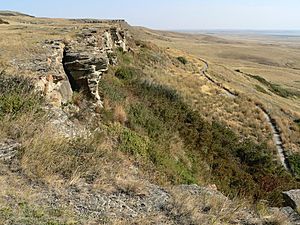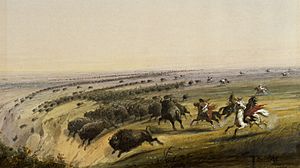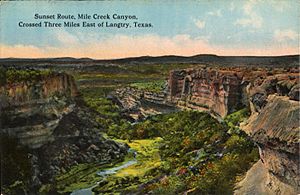Buffalo jump facts for kids
A buffalo jump (also called a bison jump) was a special cliff used by Native Americans long ago. They used these cliffs to hunt many plains bison (buffalo) at once. A game jump is a similar idea, but it's for hunting other animals like reindeer.


Contents
How Did Buffalo Jumps Work?
The Hunt Method
Hunters would carefully guide the buffalo herds. They would drive them towards the cliff. When the buffalo went over the edge, their legs would break. This made them unable to move. Tribe members waited below with spears and bows. They would quickly finish the hunt.
The Blackfoot people called these sites "pishkun". This word means "deep blood kettle". This way of hunting was a group effort. It started as early as 12,000 years ago. It continued until about the year 1500. This was around the time horses were brought to the Americas. People believed that if any buffalo escaped, the rest would learn to avoid humans. This would make hunting much harder.
Finding Buffalo Jump Sites
Buffalo jump sites often have piles of rocks called cairns. These rocks marked "drive lanes". These lanes helped guide the buffalo towards the cliff. These drive lanes could stretch for many miles.
What We Learn from These Sites
Buffalo jump sites are important for archaeologists. This is because camps and processing areas were always nearby. These sites teach us how Native Americans used buffalo. They used them for food, clothing, and shelter. The Plains Indians especially relied on buffalo for their survival.
Almost every part of the buffalo was used. Hides were made into clothes and homes. Bones became tools. Sinews (strong tissues) were used for bowstrings and laces. Hooves could be ground up to make glue. Even buffalo brains were used to help prepare the hides. Any extra meat was dried and preserved as pemmican.
A Hunter's Dangerous Job
Meriwether Lewis wrote about buffalo jumps in his journals. He described how a young, fast hunter would dress in a buffalo skin. This hunter would act as a decoy. They would stand between the buffalo herd and the cliff. Other Indians would then surround the herd. They would move forward, scaring the buffalo. The decoy would run, and the buffalo would follow at full speed towards the cliff. The decoy would then quickly hide in a safe spot in the cliff. Lewis noted that this job was very dangerous.
Even though Lewis described it, no European settlers are known to have seen a buffalo jump happen.
Famous Buffalo Jump Locations

Many important buffalo jump sites exist today. Some well-known ones include Head-Smashed-In Buffalo Jump, Bonfire Shelter, Ulm Pishkun, Madison Buffalo Jump, Dry Island, Glenrock, Big Goose Creek, Cibolo Creek, Vore, and Wahkpa Chu'gn Archaeological Site.
Ulm Pishkun Buffalo Jump
Ulm Pishkun Buffalo Jump is likely the biggest buffalo jump in the world. Native Americans used it between 900 and 1500 AD. The cliffs are over a mile long. Below the cliffs, buffalo bones are packed together. They are nearly 13 feet (4 meters) deep! Ulm Pishkun Buffalo Jump is located in First Peoples Buffalo Jump State Park. This park is in Cascade County, Montana, near the town of Ulm.
Madison Buffalo Jump State Park
Madison Buffalo Jump State Park is a state park in Gallatin County, Montana. The park covers 638 acres. It sits at an elevation of 4,554 feet. The park is named after a limestone cliff. Native Americans used this cliff for 2,000 years. They would stampede herds of bison over the cliff. This was a very effective way to hunt. Madison Buffalo Jump State Park is open all year for hiking, watching wildlife, and picnicking.
Camp Disappointment
Camp Disappointment was the northernmost point reached by the Lewis and Clark Expedition. It is one of the best-preserved buffalo jumps in Montana. This is because it is in a hard-to-reach location. The creek at the bottom of the cliff still uncovers animal bones from time to time.
You can see a 3-D model of a buffalo jump painting. It is based on a work by Charles M. Russell. This model is on display at the Helena State Capital Museum in Helena, Montana.
Images for kids


